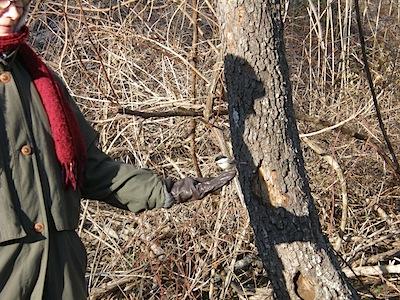Nature Notes: A Walk on the Wild Side By Larry Penny

Saturday set a record for warmth in January. Sunday was a little colder but well above freezing. My wife, Julie, and I decided to drive down Noyac Road a mile and visit the most popular United States Fish and Wildlife Refuge on Long Island, the Elizabeth A. Morton Wildlife Refuge on Jessup’s Neck.
Jessup was one of the original founders of Southampton Town and owned the 187-acre parcel that reaches halfway across Peconic Bay by virtue of a long narrow spit. The spit is glacial in origin and was once its own island, just as Robins and Gardiner’s Islands in the Peconic Estuary still are today. Down through the ages and long before settlement, much of the material eroding from both sides of the east and west sides of the “neck” drifted south, shoaling up and attaching the island to the Noyac mainland, creating a tombolo in coastal geology terms.
The upland part was mostly cut over and used for grazing livestock during settler times and eventually fell into the hands of Elizabeth Morton, who donated it to the Fish and Wildlife Service to be used by the public. Because it has a farming history it is still trying to become wild again. It has most of the native trees found on the South Fork including walnuts, various oaks, hickories, tupelos, shads, junipers, and so on, and a few trees locally rare such as the tulip tree, a very impressive specimen of which is found on its east side. It also has a small stand of a rare-to-New York State tree species, the swamp cottonwood.
It has also become one of the best examples of a wildlife refuge taken over by “invasive” species. By taking the quarter-mile walk along the trail from the parking lot on Noyac Road to the bay beach, one can find just about every one of the 50 or so problematic exotic invasives threatening Long Island’s wild. There are so many invasive species that they are not only competing with the American species, they are trying to subdue each other. Japanese honeysuckle vines wrap around Asiatic bittersweet vines. Trees-of-heaven spread their canopies widely to shade out Eurasian phragmites, multiflora rose, wineberry, autumn and Russian olives, and Tartarian honeysuckle. Pampas grass competes with phragmites reeds, wild garlic competes with mugwort, Japanese knotweed competes with boxberry. Sadly, they all seem to be outcompeting the natives, as well.
Not much too look at, there are more blow-down trees than standing ones. Rotting wood and rotting bittersweet litter the ground. But what a crowd on Sunday! Old, middle-aged, post-teens, teens, and children, all walking, standing, some chatting, some quiet. They weren’t there just because the sun was out and it was Sunday. No, they came for another reason — to feed the birds. People standing still like statues with one outstretched arm, hand palm up, sometimes for five minutes or so. But all of a sudden with a twitter and a tweet a black-capped chickadee comes out of nowhere and alights on the open hand and grabs a black sunflower seed. Just as quickly, it flies away to eat or cache it.
It’s a scene reminiscent of Francis of Assisi. First come the chickadees, then the titmice, then the cardinals, even a downy woodpecker. Wild birds are not stupid. Why scratch on the ground or peck at pieces of bark? It is much easier to sit and feed from a benevolent outstretched hand. Chickens and other fowl raised on farms were wild once, but give them grain and they’ll practically eat out of your hand. On Town Pond in East Hampton Village the mute swans and mallards that are used to getting handouts have become a major attraction that rivals other village attractions such as the Hook Mill and Mulford Farm. Just watch, local turkeys will be doing the same in the next few years.
There are so many people with different seeds to offer that the birds have become very picky, but not obese. Sunflower seeds of the dark variety seem to be the most popular. Julie and I didn’t have any seeds and took along some muesli in a plastic bag. We were the least sought after of all visitors. Apparently, birds are greener and more organic than humans. We went home with all of our muesli intact. The next morning I had it for breakfast.
The question has always been raised in wildlife circles: Does human feeding lead to loss of wildness? Just try to close your hand quickly to nab one of those little chickadees cadging a seed or two. It can’t be done. Just as birds keep one wary eye out for predators while sleeping, the chickadee in the hand studies your face and body before plucking a seed. One tiny bit of motion and he’s off like a shot. Notwithstanding the fact that visitors have been feeding birds at Morton Wildlife Refuge for more than half a century now, not one bird or chipmunk, for that matter, has gone over to the other side.
It was only a few years ago that signs were posted discouraging feeding the birds in order to safeguard their wildness. They didn’t work. Now the signs advise not to leave food on the ground as it might attract rats. Ugh! Nobody likes rats.
John Muir, Teddy Roosevelt, and Roger Tory Peterson never discouraged the human feeding of birds. It’s not the birds that are becoming more human, it is the humans that are becoming more human.
